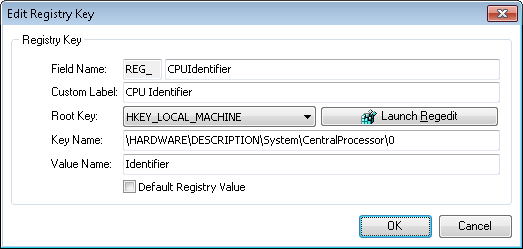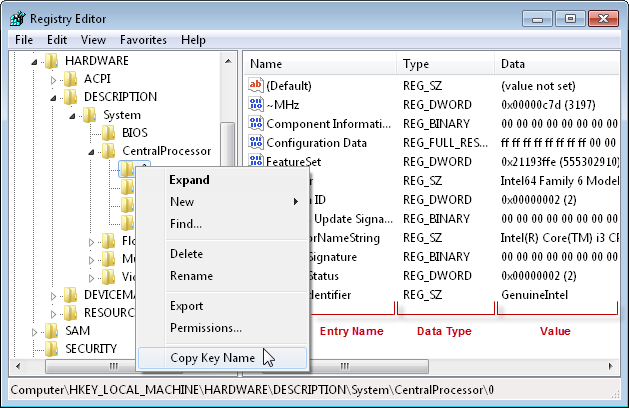Configuring registry key fields for Network Inventory
If you want to enable Network Inventory to scan the registry for a specific registry key and report its value in the audit snapshot, configure a registry key field for Computer records. As soon as you add a such a field, Network Inventory automatically enables the capture of that target registry key in all your Sites and reports its values after the first audit.
For any configuration changes to take effect, you and other users must restart the Network Inventory application. So it is recommended to configure registry key fields when users are not logged on to the database.
To add a registry key field:
-
Go to Network Inventory > Fields > Computers.
-
Click New > Registry Key Field on the Module menu. The Edit Registry Key window opens.
-
In the Field Name field, enter a physical name of the field. The name is prefixed with "REG_".
NOTE: The name must be unique. Network Inventory allows you to enter in this field English letters, numbers, and low line characters (_). Additionally, you cannot end the name with the _id sequence.
-
In the Custom Label field, type in a label for the registry key field where Network Inventory will store captured registry key values.
-
Specify the exact path to the registry key to capture.
-
Specify the registry entry to capture.
-
Click OK.
By default, Network Inventory automatically includes your newly added registry key field in all audit profiles and will capture this key on all Windows computers in all your Sites. If you do not want to capture this registry key in a particular profile, you must review this profile and disable the registry key field in the profile; see Network Inventory Help System: Registry Keys.
To modify the parameters of a registry key capture:
-
Double-click the registry key field to bring up the Edit Registry Key window.
-
Modify the capture parameters as needed.
-
Click OK.
To remove a registry key field:
-
Select the registry key field and click Delete.
Edit Registry Key window
The Edit Registry Key window allows you to add the capture of a registry key during the audit or modify the definition of a registry key field, where Network Inventory stores captured registry key values.

-
Field Name - the physical name of the registry key field.
-
Custom Label - the label of the registry key field.
-
Root Key and Key Name - the exact path to the registry key to capture. You can specify this path as either of the following:
-
If the registry on your local computer contains the target key, you can just paste it from your Microsoft Registry Editor as follows:
-
Open the Registry Editor. For example, you can just click Launch Regedit in the Edit Registry Key window.
-
In the navigation area of the Registry Editor, locate the key to query during the audit, right-click it, and choose Copy Key Name from the context menu.
-
Switch to the Edit Registry Key window in Network Inventory and paste the copied value into the Key Name field. The value of the Root Key field will be set automatically to match the selected registry hive.

-
If your local registry does not contain the target key, just enter the exact path to the key in the Key Name field. The best way is to copy and paste it from a reliable source. The value of the Root Key field will be set automatically to match the selected registry hive. Make sure that you enter the exact path to the registry key.
How to capture 32-bit application data:
In 64-bit Windows, registry entries for 32-bit applications are stored under a special registry node Wow6432Node:
HKEY_LOCAL_MACHINE\Software\WOW6432Node
If you want to retrieve a 32-bit registry key value from the HKEY_LOCAL_MACHINE\SOFTWARE section on 64-bit versions of Windows, make sure to include the Wow6432Node node in your registry path. For example:
HKEY_LOCAL_MACHINE\SOFTWARE\WOW6432Node\Adobe\Adobe Bridge CS6\Installer\InstallPath
If there are both 32-bit and 64-bit versions of Windows in your audit scope, you can use this solution to capture 32-bit application data on both 32-bit and 64-bit versions using the same registry path, because Network Inventory automatically removes the Wow6432Node node from the path when running on 32-bit Windows.
-
Value Name or Default Registry Value - the entry to capture. You can specify this entry as either of the following:
-
To specify a non-default key value, enter it in the Value Name field. The most reliable way is to copy and paste it from the Registry Editor. For example, to copy a value to the clipboard, right-click its name in the Registry Editor, choose Rename from the pop-up menu, press CTRL+C, and then press ESC to exit the replace mode.
-
To query the default key value (displayed as (Default) in the Registry Editor), select the Default Registry Value check box.
-
![]() Click here to read additional information about registry entries.
Click here to read additional information about registry entries.
By default, registry key fields are not included in any grid views for Computers. To show the column in a particular view you should modify the view configuration and add registry key fields as needed.